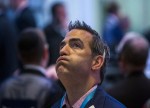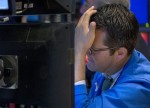
- All Instrument Types
- Indices
- Equities
- ETFs
- Funds
- Commodities
- Currencies
- Crypto
- Bonds
- Certificates
Please try another search

Breaking News
- Information
- Research
- Profile
- Press Releases
LATEST HEADLINES
- US Aug. Consumer Credit contracted $-7.9B vs. +$5.0B expected
- ABC Weekly Consumer Confidence fell to -43 from -41 last week
- UK Sep. Nationwide Consumer Confidence fell to 50 vs. 49 expected and 53 in Aug.
- UK Sep. NIESR GDP estimate at -0.2%
- Australia Oct. Westpac Consumer Confidence out at -11.0% vs. +7.0% in Sep.
- Australia Aug. Home Loans out at -2.2% vs. -1.0% expected
- Japan Sep. Bankruptcies rose 34.4% YoY vs. 4.2% in Aug.
THEMES TO WATCH – UPCOMING SESSION
Key Risk Events (All times in GMT)
- Sweden Aug. Industrial Production and Orders (0730)
- UK Sep. BRC Shop Price Index (0930)
- Germany Aug. Industrial Production (1000)
- US Fed's Plosser to Speak (1145)
- Canada Sep. Housing Starts (1215)
- US Aug. Pending Home Sales (1400)
- US Weekly Crude Oil and Product Inventories (1435)
- Japan Aug. Machine Orders (2350)
- Australia Sep. Unemployment Rate (0030)
Market Comments
The financial world appears to be going down in flames once again yesterday and overnight as equity indices around the world continue to hemorrhaged trillions of dollars in value. Yesterday, the Fed attacked the most pressing issue in credit markets at the moment - the commercial paper market, which was seizing up as companies couldn't roll over their short term debt. A new facility created by the Fed will now buy up commercial paper and even make unsecured loans to the corporate sector - an unprecedented step. The move yesterday was largely expected and pre-announced, and we might have expected a sentiment boost in its wake, but clearly the markets had a different agenda. In the financial sector, US and UK financials nosedived as Bank of America cancelled its dividend and as the expected UK bailout plan will dilute British banking shares.
While the Fed's new commercial paper buying facility is ironically especially good for European banks, who have been so desperate of late to acquire USD for their US commercial paper-based liabilities. While there is so far not much evidence of the EUR finding support here (most likely due to generalized pandemonium at present), signs of easing in the money markets in the US on the Fed announcement could boost EURUSD for at least a reasonable countertrend rally here in the short term back toward the key 1.3885 resistance.
The UK plans to roll out a massive new bailout plan this morning, which is expected to include direct injection of capital into banks in exchange for partial ownership in the banks via common shares. Many criticized the US TARP plan for not including this kind of approach, which shores up capital ratios and gives bank new reserves to work with. This should be GBP bullish and EURGBP may be interesting to the downside if it stays below the 0.7810 area (and GBPUSD might find support) and if some of the panic elsewhere in equity-land begins to ease today.
Japan suffered a psychic body blow overnight as Toyota, one of its premiere companies and brands, announced that profit would miss target by 40%. This put the Nikkei in a tailspin, and the global equity sell-off has pushed the JPY to new extremes, with USDJPY trading below 100 this morning and other JPY crosses also under pressure. We would not be surprise if the Bank of Japan is operating behind the scenes here to prevent the erosion of JPY crosses from becoming even more disorderly.
Bernanke put in an appearance yesterday and his rhetoric hinted at a rate cut to come, though the market doesn't want hints - it wants big cuts now. Could the BoE cut 100 bps tomorrow, or has all sanity left the building and they only cut 50 bps due to inflation fears...?
Last night, George Bush asked major European leaders to assemble for a summit. One wonders if the world's governments can begin to operate in a more coordinated fashion when EU leaders themselves decided that they couldn't cooperate more closely just this past weekend.
We suspected that Monday's climactic sell-off might mark the most extreme levels for now, but this is clearly not the case so far, with panic selling of equities and risky assets accelerating into the Asian close as we are writing this. Emerging market currencies have been absolutely hammered, the Japanese Nikkei was off as much as 9%, and Indonesia called a halt to trading "indefinitely" after losing more than 10% two days in a row. This is scary stuff - let's hope for signs of stability soon.
Fear levels are very high out there - normally with great fear comes great opportunity for those willing to step in and fade the fear, but we would prefer to step lightly here and let the risk cowboys show their hands before we make any bets on a recovery. One thing for sure - when markets go into "parabolic" declines, the timeframe of searching out a local low is very compressed - meaning that the lows will likely be in for this move in a matter of a few days to two weeks. And the biggest rallies in history often come within bear markets. In FX land, the bounce will be largest, of course, in those currency pairs that have been hit the hardest.





